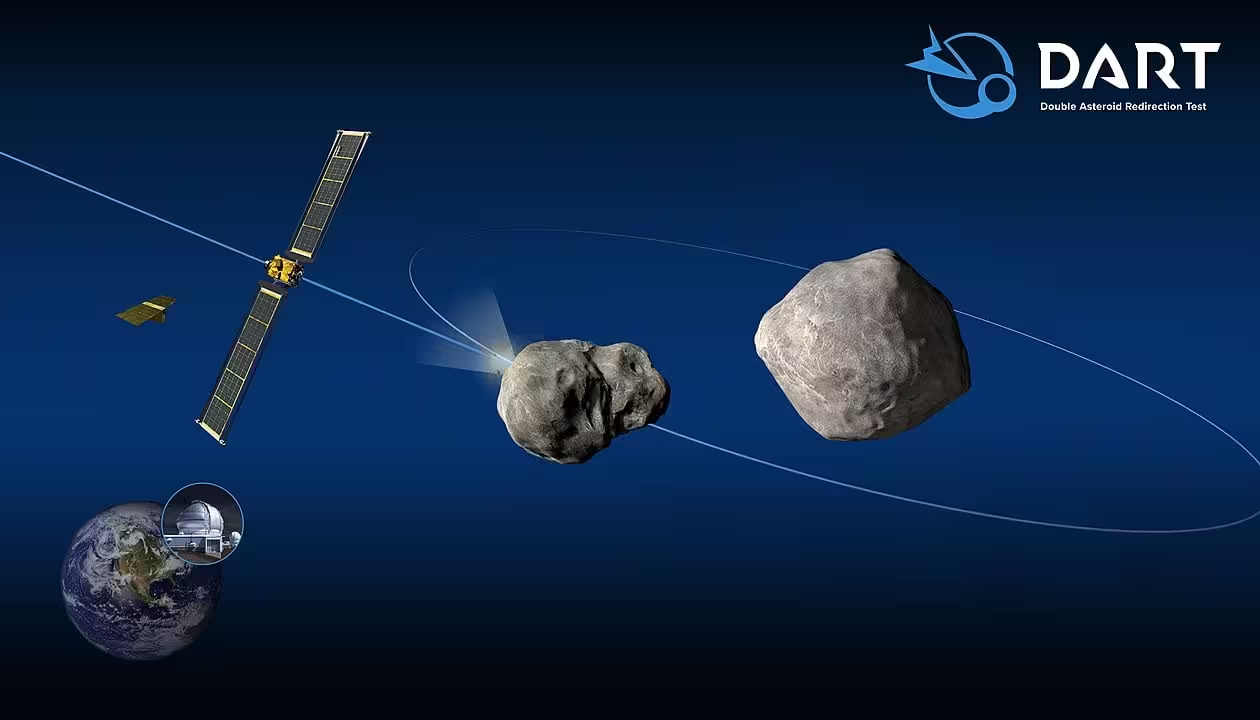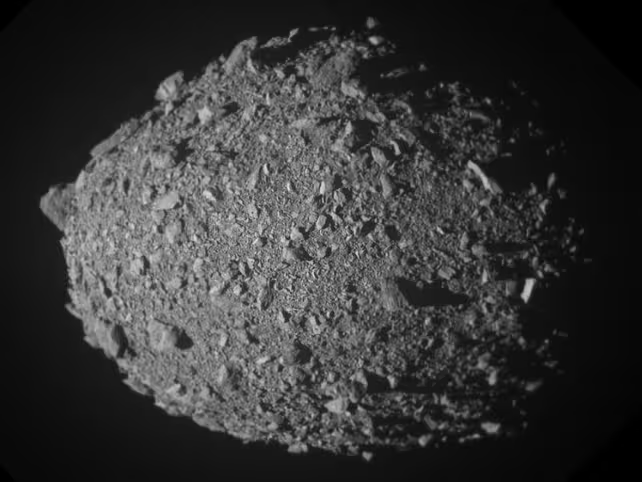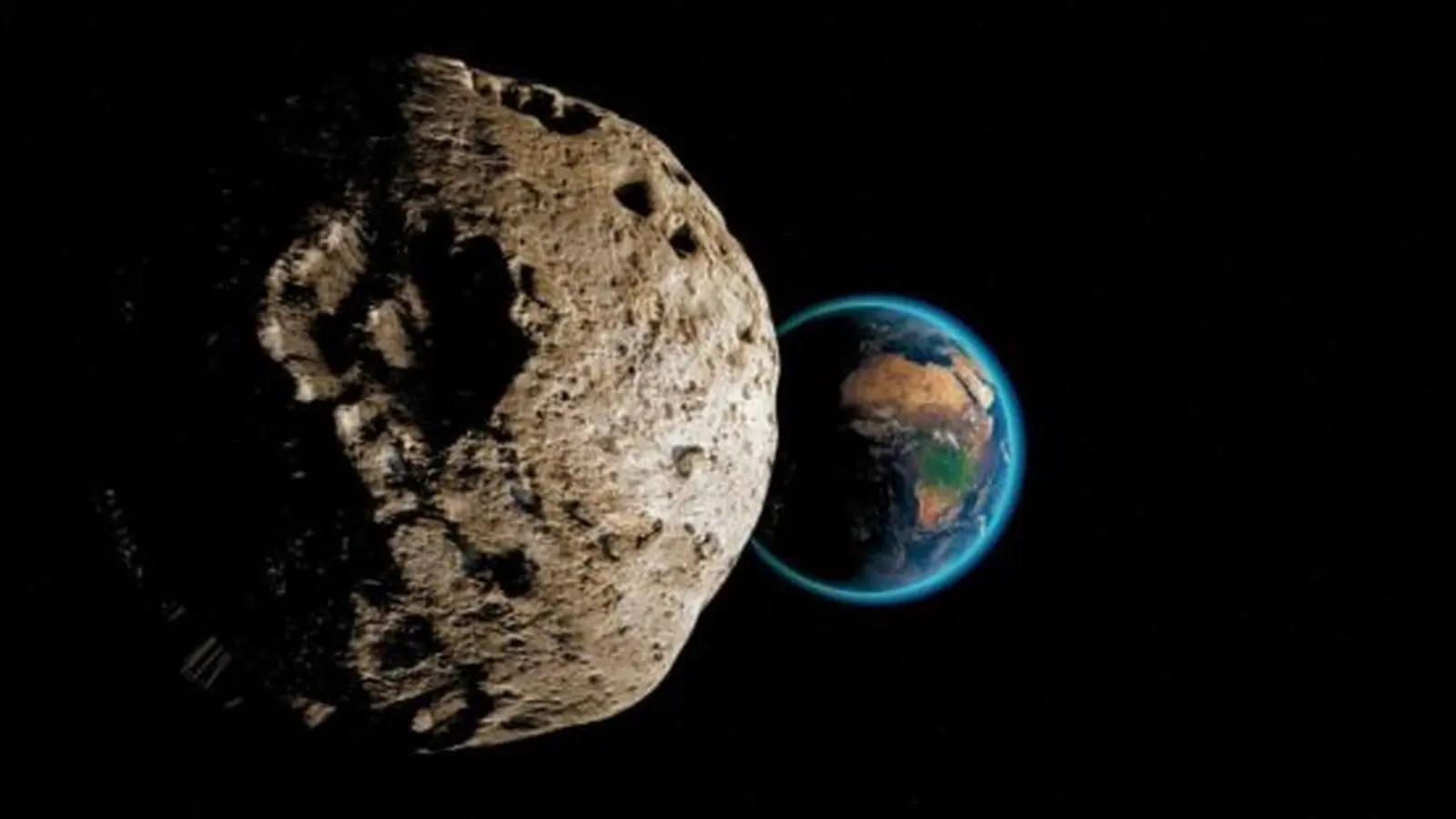8 Minutes
The promise and perils of kinetic deflection
When an asteroid is determined to be on a collision course with Earth, the leading near-term response in planetary defense is kinetic deflection: deliberately striking the object with a spacecraft to change its trajectory. The concept was validated in 2022 by NASA's Double Asteroid Redirection Test (DART), which deliberately impacted the small moonlet Dimorphos and measurably altered its orbit around the larger asteroid Didymos.

Schematic of the DART mission showing the impact on the moonlet of asteroid (65803) Didymos. Redirection missions like this need to ensure any impact does not simply delay impact! (DART)
DART demonstrated that a kinetic impactor can work. But new research led by scientists at the University of Illinois highlights a subtle and serious risk: striking an asteroid at the wrong location can change its orbit in such a way that the object later passes through a narrow region of space known as a gravitational keyhole. If that happens, the planet’s gravity can bend the asteroid’s path and set it on a collision course with Earth years or decades after the deflection.
What is a gravitational keyhole and why it matters
Defining the keyhole
A gravitational keyhole is a small zone in space near a planet’s orbit where a close approach alters an asteroid's trajectory such that a subsequent orbital return results in impact. Keyholes are typically very narrow—sometimes only a few hundred meters to a few kilometers across—so tiny changes in position or velocity at the time of a close encounter can determine whether an asteroid will hit the keyhole or safely miss it.
Think of the Sun–planet–asteroid system like a complex pinball table: nudging the asteroid in the wrong direction can send it toward a bumper that redirects it back toward the flippers. In orbital dynamics terms, the planet’s gravity during a close approach acts as the bumper that can transform an otherwise harmless orbit into a future impact trajectory.
Probability maps: targeting deflection to avoid future risks
To reduce the risk of inadvertently steering an asteroid into a keyhole, the University of Illinois team has developed probabilistic surface maps that show, for each point on an asteroid, how likely a kinetic impact at that location is to produce a future passage through a keyhole. These "probability maps" combine orbital dynamics, uncertainties in impact outcomes, and the asteroid's physical properties to identify safer and riskier strike zones.
Creating a useful probability map requires detailed information about the target asteroid: its shape, mass distribution, rotation rate and axis, surface topography, and internal structure. Those parameters determine how an impact will change the asteroid’s translational and rotational state—and hence its heliocentric orbit after the encounter.
When high-fidelity data are available from a rendezvous spacecraft and close-range imaging, maps can be precise. For well-characterized objects such as Bennu (studied by OSIRIS-REx), researchers can already produce refined maps that indicate optimal impact regions and quantify mission uncertainties—important because even a carefully guided spacecraft may miss the intended point of contact by meters to tens of meters.
However, the team also emphasizes pragmatic approaches for late-warning scenarios. If an object is discovered with limited lead time, lower-resolution probability maps can be generated from ground-based telescope observations and radar, providing rough guidance for emergency deflection attempts.

Mission context and implications for planetary defense
DART’s success was an important proof-of-concept for kinetic impactors, but the Didymos–Dimorphos system was selected because its dynamics make an Earth-impact trajectory unlikely even after perturbations. Future real-world threats may not be so forgiving. Planetary defense missions will need far more precise planning: predicting post-impact orbital evolution, accounting for uncertainties, and ensuring a deflection does not shift an asteroid into a dangerous resonant corridor.
This is one reason the European Space Agency’s Hera mission—scheduled to reach the DART impact site in late 2026—matters. Hera will perform close-up surveys of Dimorphos and the DART impact site to measure the mass, shape, and crater properties created by the impact. Those observations will refine models of momentum transfer, ejecta behavior, and orbital change—data that feed directly into better probability maps and improved mission planning for future deflection attempts.
Key technologies and methods that play into this approach include:
- High-resolution imaging and laser altimetry from rendezvous spacecraft to map surface features and derive accurate mass distribution.
- Ground-based radar and optical tracking to constrain pre-impact orbits and rotation states.
- Monte Carlo simulations and covariance analysis to quantify uncertainties in impact outcomes and orbital evolution.
- Rapid mapping workflows for scenarios where lead time is measured in months rather than years.
Key discoveries and practical steps forward
The Illinois team’s chief insight is that targeting matters—not just that an impact occurs, but where on the asteroid it occurs. Probability maps turn that insight into an operational tool. Instead of a single objective to "push the asteroid off course," planetary defense planners can adopt a twofold objective: (1) change the asteroid’s orbit enough to avoid impact with Earth, and (2) ensure the post-deflection orbit does not cross a gravitational keyhole leading to future impact.
Operationally, that means integrating surface targeting into mission design, developing guidance systems capable of hitting designated safe zones, and increasing investment in reconnaissance missions that acquire the physical data needed to build reliable maps. It also means validating the mapping approach with laboratory experiments, impact modeling, and observations from missions such as DART and Hera.
Expert Insight
Dr. Rahil Makadia, lead researcher on the mapping study and a planetary defense specialist, explains: "A successful deflection is not just about changing velocity; it’s about changing trajectory in a way that removes long-term risk. Our probability maps help planners choose impact sites that minimize the chance of driving an asteroid into a resonant path or keyhole. In an emergency, even coarse maps are better than none—because they let us prioritize strikes that reduce the likelihood of a delayed disaster."
Emma Flores, a systems engineer with experience in guidance, navigation and control for small-body missions, adds: "Precision targeting at the scale required is challenging but achievable. We need to combine autonomous guidance with pre-mission reconnaissance to ensure the kinetic impactor hits the intended window on a rotating, irregular surface. Passing that data into real-time navigation algorithms will be essential for high-confidence planetary defense operations."
Practical readiness and when time is short
If an incoming asteroid is detected with months or years to spare, a rendezvous mission should be the preferred first step to characterize the target and create high-quality probability maps. If, instead, detection comes late, decision-makers will face trade-offs: launch a rapid kinetic impact with lower targeting confidence, initiate multiple small-impactor strikes to spread the risk, or explore alternative mitigation methods (e.g., gravity tractors) when time allows.
Multiple, independent deflection attempts or combined techniques could reduce the odds of inadvertently nudging an object into a keyhole. Redundancy, cross-validation of models, and international coordination will be vital elements of any future planetary defense campaign.
Conclusion
The DART mission proved a kinetic impactor can alter an asteroid’s orbit—an essential milestone for planetary defense. New research shows that the location of that impact matters critically: a poorly aimed strike could steer an asteroid through a gravitational keyhole and postpone an Earth impact rather than prevent it. Probability maps that integrate an asteroid’s shape, rotation, mass, and orbital uncertainties offer a practical way to choose safe strike zones. Coupled with reconnaissance missions such as Hera, improved mapping, and precise guidance systems, these tools will make future deflection campaigns safer and more reliable. In short, planetary defense is not only about delivering an impact, but about delivering it in the right place, at the right time, with the right data supporting the decision.
Source: sciencealert


Leave a Comment